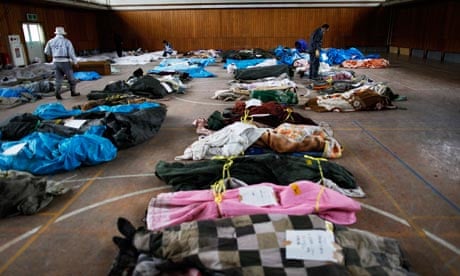Japan's humanitarian crisis has intensified with relief workers being hampered by freezing temperatures and snowfalls while survivors struggle with shortages of water, food and electricity.
Japan's prime minister, Naoto Kan, ordered a shift in the focus of relief efforts from search and rescue to caring for an estimated half a million people who have been evacuated from provinces affected by the earthquake and tsunami and many others who have been left homeless.
The disaster has damaged or destroyed about 60,000 buildings, but the magnitude of the human toll is not yet reflected in figures from the National Police Agency emergency disaster headquarters which show 2,475 dead and 3,118 people missing. The final death toll could rise far beyond 10,000. Save the Children said a fifth of those displaced were children and warned the disaster could result in many being orphaned.
As a powerful aftershock rocked Shizuoka, south west of Tokyo, about 1.4m households remained without water and 843,000 households serviced by Tokyo Electric and Tohoku Electric power companies experienced power cuts. Rolling blackouts affected about five million people.
"People are exhausted both physically and mentally," said Yasunobu Sasaki, the principal of a school converted into a shelter in Rikuzentakata, a nearly flattened village of 24,500 people in the far-northern Iwate prefecture.
"We survived, but what are we supposed to do from here?" said Sachiko Sugawara, 63, now living at one of the shelters.
Officials in Iwate reported they had lost contact with about 30,000 people, raising concerns of a dramatic increase in the number of deaths.
An estimated 10,000 people, half of the population of Minami Sannriku town in Miyagi prefecture, had not been contacted. Across the country, more than 550,000 people are living in temporary shelters.
International relief agencies have been kept out of zones affected by radiation leaks from damaged nuclear power stations. Panic increased after another explosion at Fukushima nuclear plant, increasing radiation levels in the area.
"These latest developments will obviously make the humanitarian effort more difficult," said Red Cross spokesman Francis Markus.
Red Cross worker Patrick Fuller told the BBC that the situation around the coastal town of Otsuchi was desperate, with people scavenging for food and rescue teams trying to put out forest fires. "I was up at one of the evacuation centres today where there were probably about 300 people just lying on the floor on sheets of cardboard, a lot of them elderly people," he said, adding that there were crowds milling around looking for lost relatives.
Foreign governments have sent more than 800 emergency relief workers and the Japanese Red Cross has deployed about 90 medical teams to provide basic care for about 430,000 people in remote coastal towns.
The threat of nuclear fallout caused panic buying of petrol as people filled their vehicles in anticipation of having to flee a cloud of radioactive gas. Many petrol stations were closed and some rationed sales to 10 litres per car.
Save the Children estimated that as many as 100,000 children may have been displaced. The British charity said it was concerned that some of the children affected by the disaster may have also been separated from their families because the earthquake and tsunami struck in mid-afternoon when many children were at school or nursery.Stephen McDonald, who is leading Save the Children's team in Japan, said the most pressing worries for children living in evacuation centres were lack of water and psychological problems associated with trauma and stress.
"Children we talk to say that whenever there's a tremor they are scared that something is going to happen," McDonald told the Guardian from Sendai, where the organisation has set up an operations base.
About a quarter of the 1,200 people sleeping on cardboard mats at one shelter in Sendai were children, many of them with disabilities.
"Water is a concern here, but there is a large number of volunteers who are providing food and trying to make the place comfortable," McDonald said. "We've been told that people could be here for at least three months. The big question is what we do after that."
The charity fears that many there children were separated from their parents and relatives by the tsunami or during the chaos that followed.
